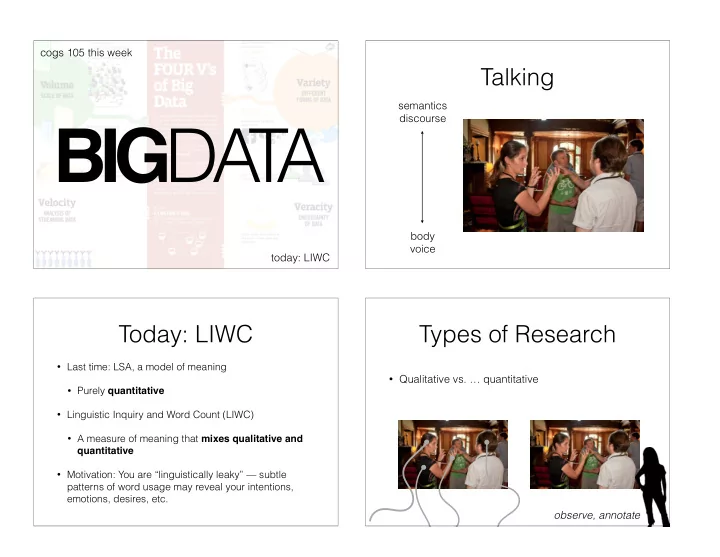

cogs 105 this week Talking semantics discourse BIG DA T A body voice today: LIWC Today: LIWC Types of Research • Last time: LSA, a model of meaning • Qualitative vs. … quantitative • Purely quantitative • Linguistic Inquiry and Word Count (LIWC) • A measure of meaning that mixes qualitative and quantitative • Motivation: You are “linguistically leaky” — subtle patterns of word usage may reveal your intentions, emotions, desires, etc. observe, annotate
Quantitative Qualitative Quantitative Qualitative spectrum spectrum working not working human-coded with working with LIWC with measures quantities quantities research quantities in LIWC statistical very the statistical research case study / models complex middle models in comparison (e.g., t-tests) variables (e.g., t-tests) the (verbal, descriptive) middle Linguistic Inquiry and Word Count automated human-coded measurement measures Use human coders to categorize words, in terms of their often meaning, then create a system that lets us use those very simpler categories to quantify text in various ways… complex variables variables Examples Examples “she” “sad” • What the word “I” means can be described in pronoun terms of the categories in which this word can be “happy” “he” placed. E.g.: pronoun , self “I” • How about the word “challenge”: emotion , positive “we” emotion emotion , achievement self positive emotion • Each word can be in many categories; each “challenge” category has many words. achievement • LIWC now has almost 5,000 words! “win”
Qualitative Methods LIWC Is, in Part, a Dictionary • LIWC used qualitative coding by human participants in order to get these Word Category dictionaries… I pronoun, self • Human judges (about 5) worked together to help (i) pick the words, (ii) pick the categories, and (ii) categorize the words . we pronoun, self • Judges achieved inter-rater reliability: she pronoun, self, female • The process of comparing judge categorizations to determine how challenge emotion, positive emotion, achievement closely judges agreed. Where they do not have a majority vote, they win achievement, etc. either removed a word or negotiated to come to agreement. Ultimately, LIWC’s scores are based on over 90% agreement by judges. happy emotion, positive emotion see senses, vision, etc. Cognitive Questions… LIWC Is Quite Transparent 9 words. • After LIWC has hand-coded these categories, we can “I walked. She drove. 3 pronouns (33%) now use them to quantify text. We met at the store.” 2 self words (22%) • Questions we might ask: • How much do people refer to themselves? • How sad are people? How negative? • How much do they talk about their job? • How often do they make social references? http://www.liwc.net/
LIWC as “Forensic Cognitive Questions Linguistics” • LIWC has been applied all over the place. The • How much do people refer to themselves? reading provides some very nice details… • Turns out, liars tend to use language in a way to • The idea is that subtle linguistic usage, especially minimize first-person singular. such things as stylistics (pronouns, prepositions, etc.) might serve as a kind of “linguistic forensic” • LIWC has been used to quantify text that device, that could detect some psychological states. contains lies. Fewer “I”s! • Also find that depressives use more first-person singular.
Cognitive Questions Cognitive Questions • How sad are people? How negative? consistent changes in their linguistic styles. With increasing age, individuals used more positive emotion words, fewer negative emotion words, fewer first person • Turns out, participants who are more neurotic singular self-references, more future tense, and fewer past tense verbs. Age was also positively correlated with an increase in cognitive complexity (e.g., causation tend to have correlated negative word usage. words, insight words, long words). In addition to challenging some of the cultural stereotypes on aging, these results suggest that language use can serve as a subtle ranging between 0.10 and 0.16. Overall, neuroticism was positively correlated with linguistic age marker. use of negative emotion words and negatively with positive emotion words; ex- traversion correlated positively with positive emotion words and words indicative of social processes; agreeableness was positively related to positive emotion and LIWC could serve as a kind of linguistic negatively to negative emotion words. In addition, neuroticism was characterized diagnostic tool for different stages in life… by a more frequent use of first person singular, a finding that is consistent with the idea that excessive use of first person pronouns reflects a high degree of self- involvement (e.g., Davis & Brock 1975, Ickes et al. 1986, Scherwitz & Canick http://www.analyzewords.com/
Grades Sections • Final paper • Going to lab ensures you understand the task — • Our coverage of diverse material is partly designed to help expose you to you can even check to make sure it is correct many techniques. before you submit it to your TA. • In the final paper, you will choose one method, and expand a lab into a paper project. • You can ask any questions about the task, and • Choose something that is related to career interests . make sure you understand the procedures. • E.g., philosophy grad school - build a thought experiment? • Ask your TA about careers in cognitive science! • E.g., forensic psychology - LIWC? • E.g., CogSci grad school - RT experiment? • Don’t forget extra SONA credit. • E.g., cog neuro interests - Neurosynth exploration? Exam 2 / Next Week • Date for next exam: March 31st , after spring break. • Review guide posted well before spring break. • One more section before exam two: neural network models • From computer analysis in big data to computational modeling using neural network
Recommend
More recommend